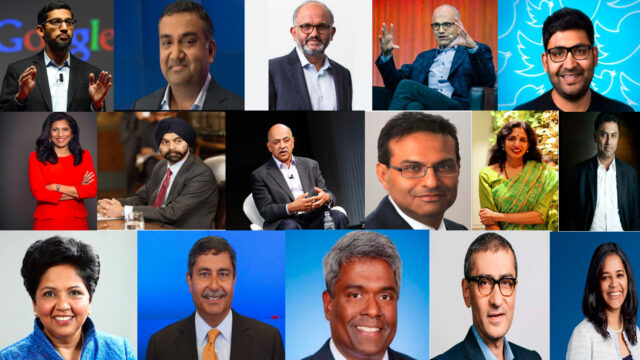The Legislative Roots of America’s New Indian Overclass

Last December was a mask-off moment for failed presidential candidate Vivek Ramaswamy. At the height of the debate over H-1B visas, Ramaswamy took the side of known H-1B booster Elon Musk and proceeded to criticize American culture for glorifying the prom queen instead of the math olympiad winner, or the star athlete over the top student.
Ramaswamy suggested that glorifying superficial social archetypes like Chads and Stacys has undermined the U.S.’s capacity to develop top-tier engineering talent. He was rightfully criticized by the more nationalist elements of the America First movement for his initial support of H1-B visas, which allow tech firms to bring in foreign workers for specialized roles, with the possibility of transitioning to permanent residency (green card).
This internal fight within the Trump movement is relevant due to the uncomfortable realities of this visa program. It’s no secret that Indian nationals dominate the United States H-1B visa program. Indian nationals received 279,386 H-1B visa approvals in fiscal year 2023, representing 72.3% of all H-1B visas issued during that period.
Despite the backlash he encountered last year, Ramaswamy sees momentum on his side, underscored by his recent gubernatorial bid in Ohio. Ramaswamy’s story reflects the rise of a powerful Indian overclass in America, one that increasingly sees the country as theirs for the taking. In most major American cities today, it’s become commonplace to encounter individuals hailing from the Indian subcontinent. Standing at around 5.2 million people, Indians are one of the fastest growing foreign nationalities in the United States. For perspective, the Indian population was hovering at around 1.8 million in 2020.
This contemporary reality of a surging Indian population didn’t emerge overnight but represents the culmination of a carefully orchestrated legislative evolution that began with a modest but revolutionary piece of legislation: the Luce-Celler Act of 1946, introduced by Rep. Clare Boothe Luce (R-CT) and Rep. Emanuel Celler (D-NY).
Prior to 1946, Indian nationals faced stiff barriers to both immigration and citizenship. The 1917 Immigration Act had established an “Asiatic Barred Zone” that effectively prevented most Asian immigration to the United States, while the landmark 1923 Supreme Court case United States v. Bhagat Singh Thind ruled that Indians, despite being classified as “Caucasian,” could not be considered White under naturalization laws and were therefore ineligible for citizenship.
The Luce-Celler Act of 1946, signed into law by President Harry S. Truman on July 2, 1946, represented the first crack in the immigration wall. Though modest in scope—allowing only 100 Indians annually to immigrate and granting them the right to naturalize as American citizens—the act was revolutionary in principle. For the first time since the early 20th century, Indians could legally immigrate to the United States and, crucially, own property and petition for their immediate family members to join them.
The geopolitical landscape of the Cold War would later provide the ideal backdrop for expanding Indian immigration. As the United States sought to position itself as a beacon of capitalism and liberal democracy against Soviet communism, restrictive immigration policies were viewed with increasing skepticism by policymakers in Washington. To convince the world of the perceived superiority of the American capitalist model, U.S. political leaders felt it necessary to open the immigration floodgates and allow for non-Whites of all stripes to reap the fruits of American capitalism.
Emanuel Celler, a tireless champion of Jewish causes, would strike again by teaming up with Sen. Philip Hart (D-MI) to introduce the Immigration and Nationality Act of 1965—also known as the Hart-Celler Act. This legislation abolished the national-origins quota system that had governed American immigration policy since the 1920s.
From there, this legislation fundamentally transformed the demographic composition of American immigration. Prior to the Hart-Celler Act, the United States was 85% White. However, by removing racial and ethnic barriers, it opened the door for unprecedented immigration from Africa, Asia, and Latin America. The act created a seven-category preference system that prioritized family reunification and “skilled” workers—categories that would prove particularly beneficial to Indian immigrants.
The impact was immediate and dramatic. From fewer than 1,000 Indians in the United States by 1900, the population began to surge. Educational exchange programs and new temporary visas for so-called “skilled” workers created pathways for educated Indian immigrants, many of whom brought their families. From 1980 to 2019, the Indian immigrant population increased thirteen-fold.
The Immigration Act of 1990, signed by President George H.W. Bush, further accelerated Indian immigration by increasing overall immigration limits and creating new employment-based visa categories. The act allowed 700,000 immigrants annually for fiscal years 1992–94 and 675,000 thereafter, while establishing five distinct employment-based visa categories and expanding the H-1B visa program for “highly-skilled” workers.
This legislation coincided with the technology boom that would define the 1990s and 2000s. Indian immigrants, particularly those with rudimentary technical skills who were willing to work for substantially lower wages, found themselves perfectly positioned to take advantage of America’s growing demand for software engineers, computer programmers, and IT professionals.
Perhaps no aspect of Indians’ economic takeover of the United States is as visible as their dominance in certain business sectors. Indians, primarily from the Indian state of Gujarat, are estimated to own between 80% and 90% of motels in small towns across America. According to the Asian American Hotel Owners Association, Indians operate 34,000 of the approximately 50,000 hotels in the United States, with 89% of all hotels in Texas owned by Indians.
Indians’ entrepreneurial inroads have extended to convenience stores, where South Asians own an estimated 50,000 to 70,000 stores—between 34% and 48% of all convenience stores in the country. The National Coalition of Associations of 7-Eleven Franchisees reports that South Asians own over 50% of the chain’s franchised stores. In California alone, 600 to 700 of the 1,200 7-Eleven stores are owned by South Asians.
The 2010s witnessed Indians ascend into a veritable overclass in the technology sector. Having drawn Indian software talent since the 1970s and 1980s, Silicon Valley eventually experienced a remarkable rise of Indians heading top companies. From Vinod Khosla co-founding Sun Microsystems to Sabeer Bhatia establishing Hotmail, to the current generation including Sundar Pichai as CEO of Google and Satya Nadella as CEO of Microsoft, Indian immigrants have fundamentally re-shaped American technology.
The H-1B visa program has played a key role in this transformation. In 2024, Indian tech companies accounted for 20% of all H-1B visas granted by the United States, with Infosys leading with 8,140 visa recipients, followed by Tata Consultancy Services with 5,274. These companies, along with others like HCL America, Cognizant, Wipro, and Tech Mahindra, have consistently ranked among the top employers of H-1B visa holders.
The transformation of Indian immigration to the United States exemplifies how incremental legislative changes can generate dramatic demographic outcomes. What began with the modest Luce-Celler Act’s quota of 100 immigrants per year has evolved into a community of over five million that are gradually displacing White Europeans in America’s business, technological, and cultural sectors.
This does not augur well for White America. As striver class Indians such as Vivek Ramaswamy gain more prominence in American public life, Whites will become increasingly pushed out of elite institutions. In time, Indians and other “skilled” migrant groups will function as frontmen for a Jewish oligarchy looking for new golems to unleash against Whites. As this author has previously noted, Indians appear to be forging an unholy alliance with world Jewry in a newfound attempt to disempower the state-forming peoples of Europe and the New World.
The depth of this alliance remains uncertain. But when it comes to undermining White political power, groups like Indians have proven strategically useful to organized Jewish interests. We should not forget that the “browning” of America’s elite didn’t happen by accident—this outcome was driven by policy, the product of Jewish zealots like Emanuel Celler who reshaped the nation’s demographic destiny.
As Vladimir Lenin asked, “Who, whom?” This question about who truly wields power must be answered in the decades to come. Until we identify the actors behind multiracialism—the proverbial “who”—we’re just chasing shadows.
Without that clarity, we can’t draw a meaningful friend-enemy distinction. Instead, we’re left with a failed system where ambitious non-Whites like Indians continue to gorge on the remains of a dying nation, while Jewish oligarchs sip cocktails in their gated resorts, watching the collapse they helped orchestrate—with zero fear of consequence.
